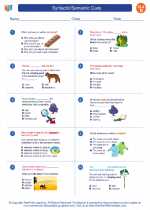Syntactic/Semantic Cues Study Guide
Syntactic and semantic cues are important components of language comprehension. Understanding these cues can help readers make sense of the text and develop strong reading comprehension skills.
Syntactic Cues
Syntactic cues refer to the grammatical structure and word order within a sentence or passage. These cues help readers understand the relationships between words and phrases, and how they come together to form meaning.
Examples of syntactic cues include:
- Word order
- Punctuation
- Conjunctions (and, but, so, because, etc.)
- Verb tense and agreement
Understanding these cues can help readers interpret and comprehend the intended meaning of a sentence or passage.
Semantic Cues
Semantic cues refer to the meaning of words and phrases within a sentence or passage. These cues help readers understand the content and message conveyed by the text.
Examples of semantic cues include:
Understanding these cues can help readers infer the meaning of unfamiliar words and grasp the overall message of the text.
How to Use Syntactic/Semantic Cues
When reading a text, it's important to pay attention to both syntactic and semantic cues to enhance comprehension. Here are some strategies for using these cues effectively:
- Pay attention to word order, punctuation, and conjunctions to understand the relationships between words and phrases.
- Use context clues and word meanings to infer the meaning of unfamiliar words.
- Look for clues within the text to understand the overall message and purpose of the passage.
- Practice identifying and using both syntactic and semantic cues through reading comprehension exercises and activities.
Conclusion
By understanding and utilizing syntactic and semantic cues, readers can improve their comprehension skills and become more proficient in understanding and interpreting written text.
[Syntactic/Semantic Cues] Related Worksheets and Study Guides:
.◂English Language Arts Worksheets and Study Guides Fourth Grade. Syntactic/Semantic Cues

 Worksheet/Answer key
Worksheet/Answer key
 Worksheet/Answer key
Worksheet/Answer key
